Lionfish: There are 16 species of lionfish ...
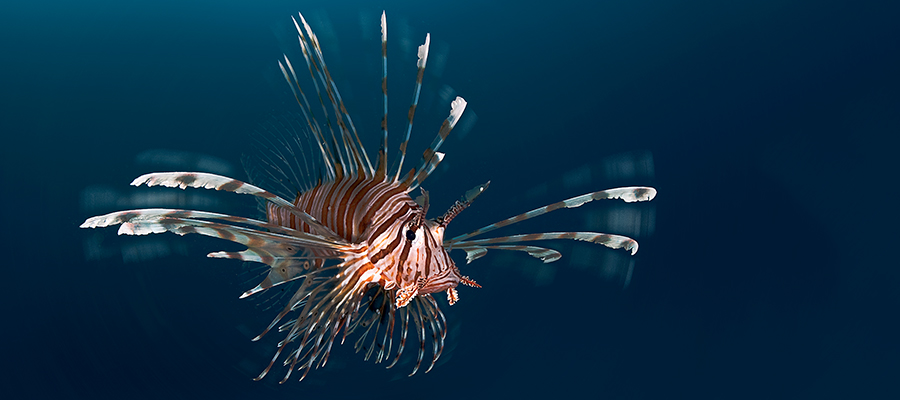 All lionfish have eleven to thirteen venomous dorsal spines.
All lionfish have eleven to thirteen venomous dorsal spines.
Did you know? ...
+ Anemonefish+ Frogfish
+ Lionfish
+ Mandarinfish
+ Moray eels
+ Rhinopias
+ Ghost pipefish
+ Sea cows
+ Seahorses
Lionfish are certainly one of the most beautiful and most striking inhabitants of the reef. Thanks to their beautiful fins you see them sometimes very graceful floating above the coral. Their main characteristics are the unbranched fin rays and their spotted membranes.
All lionfish have eleven to thirteen dorsal fin rays, three anal spines and two fan-like pectoral fins. But it is important to know that the rays of the lionfish are connected to venom glands. Hence probably the name lionfish. Probably he got his English name from its fins, where they are compared with the manes of a lion.
Lionfish belong to the family of scorpion fish (Scorpaenidae) which also includes stonefish. The lionfish is not as venomous as the stonefish but a sting will very quickly cause swelling, severe local pain, breathing difficulty and sometimes also cause heart problems. Luckily their venomous fins are not used for hunting but as of defense. In case of danger he usually rises his dorsal spines and points them towards its intruder or opponent.
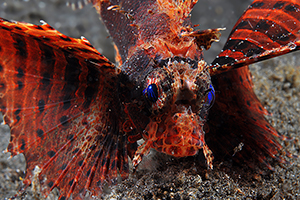 Dwarf lionfish
Dwarf lionfish
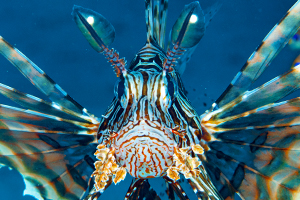 Closeup lionfish
Closeup lionfish
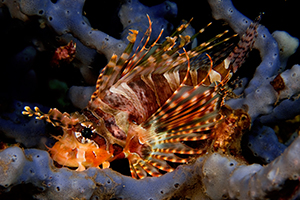 Dwarf lionfish
Dwarf lionfish
At daytime lionfish are mostly hidden and hang upside down in small caves and overhangs.
At dusk they become active and go hunting. Lionfish feed on small fish, shrimps and crabs.
Extremely slowly and carefully he starts to spread its fins and to drive its prey into a corner.
With a lightning speed he then moves forward and with a remarkable speed sucks his prey inside before swallowing.
The colour and the size of the lionfish depend on the species. The body of most species is dominated by a red, brown or maroon colour with white stripes along the body and fins. Lionfish are divided into three genera: Pterois, Dendrochirus and Nemapterois. The last two species are considered as dwarf lionfish. They reach a size of 20 to 25 centimeters while the first genera can grow over 40 centimeters.
Lionfish can lay up to 30,000 eggs per month. Female and male come together at the surface and carry out a short courtship. Here they swim a few times up and down. She releases her eggs, which are now as one big mass of jelly stick together. Immediately just after, in open water they get fertilized with the sperm of the male. The jelly dissolves and the young fish are born after a few days. After birth they are almost transparent, with a diameter of a few millimeters. A few days later they seek calm water. Here they will spend the first months of their life and they feed on plankton.
The best time of day to photograph lionfish is during a night dive. You will have absolutely no difficulty finding one, because you will pretty soon find out that they are attracted by the light of your dive light.
Species of lionfish, genus Pterois :
The colour and the size of the lionfish depend on the species. The body of most species is dominated by a red, brown or maroon colour with white stripes along the body and fins. Lionfish are divided into three genera: Pterois, Dendrochirus and Nemapterois. The last two species are considered as dwarf lionfish. They reach a size of 20 to 25 centimeters while the first genera can grow over 40 centimeters.
Lionfish can lay up to 30,000 eggs per month. Female and male come together at the surface and carry out a short courtship. Here they swim a few times up and down. She releases her eggs, which are now as one big mass of jelly stick together. Immediately just after, in open water they get fertilized with the sperm of the male. The jelly dissolves and the young fish are born after a few days. After birth they are almost transparent, with a diameter of a few millimeters. A few days later they seek calm water. Here they will spend the first months of their life and they feed on plankton.
The best time of day to photograph lionfish is during a night dive. You will have absolutely no difficulty finding one, because you will pretty soon find out that they are attracted by the light of your dive light.
Species of lionfish, genus Pterois :
Species of dwarf lionfish, genus Dendrochirus :
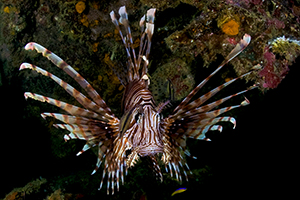 Pterois antennata
Pterois antennata
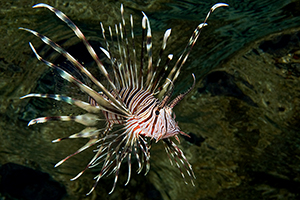 Pterois miles
Pterois miles
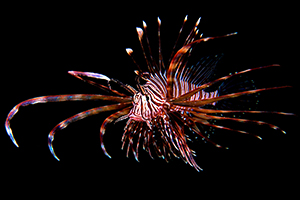 Pterois volitans
Pterois volitans
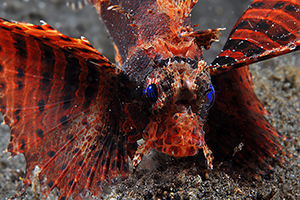 Dendrochirus brachypterus
Dendrochirus brachypterus
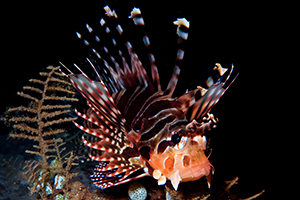 Dendrochirus zebra
Dendrochirus zebra